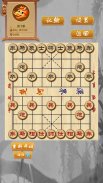







中国象棋-残局单机版

Description of 中国象棋-残局单机版
Chinese chess is a type of chess that originated in China. It is a kind of confrontational game between two players. It has a long history in China. Because of its simple equipment and strong interest, it has become a very popular chess activity.
Chinese Chess is a Chinese chess culture and a cultural treasure of the Chinese nation. It has a long history, full of interest, and the basic rules are simple and easy to understand. The foundation of Chinese chess far exceeds that of Go in the masses of China, and it is the most popular chess game. Chinese chess has spread to more than a dozen countries and regions.
Chinese Chess uses a square grid board, with 32 round pieces in total and 16 pieces in each of the red and black colors. They are placed and moved at the intersection. The two sides play chess alternately, and the "checkmate" of the opponent's general (handsome) wins first.
The game has the following endgame categories:
Double car class Bicycle class
Chariots and horses and cannons Chariots and horses and cannons
Chariots and soldiers
Double horse class Single horse class Horse soldier class
Double cannon type Single cannon type Artillery type
Horse Artillery Horse Artillery Soldier
Practical Endgame 100 Zhou Mengfang's residual row Yi Hai Zhengfan
Yihai Yanbo Modern Arrangement Old Chess Score
Chess roadside stall
Miaohe Hundred Games Score of Young Children Hundred Games Score of Three Kingdoms and Seven Sons
Seven sons in a hundred innings, winning endgame, Tao Qingyiqu
Endgame attack
rule:
The horse walks day, the elephant walks the field, the car walks straight and cannon over the mountain, the taxi walks diagonally to guard the side, and the pawn never returns. The car went straight and the horse stepped diagonally.
This is the formula of Chinese chess. The explanation is: the horse is a cavalry, walking straight and cutting diagonally, so it walks the sun; like a military division, defending the camp, so it walks the field. The car is a chariot, rambling, so it goes straight. The cannon is a cannon, and it hits far away in the air, so it is called overturning the mountain. The soldiers are guards, personal protection, so they are on the side. A soldier is like Jing Ke, of course it is gone forever.
In the early days of chess, the chess system consisted of three tools: chess, chopsticks, and game. The two sides play chess, each with six children: Xiao, Lu, Pheasant, Calf, and Si (two pieces). The chess pieces are carved from ivory. Chopsticks are equivalent to dice, and chopsticks must be thrown before chess. The game is a square chessboard. In the game, "throw six chopsticks, play six chess", fight skillfully and wit, attack and force each other, and control the opponent to death. During the Spring and Autumn and Warring States period, the military system consisted of five people, and one corps leader, with a total of six people. At that time, it was used as a military training football game with six people per side. This shows that early chess was a game that symbolized fighting at that time. On the basis of this chess system, a chess game called "Sai" appeared later, which only played chess without throwing chopsticks, and got rid of the element of chance to win in early chess.


























